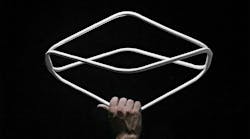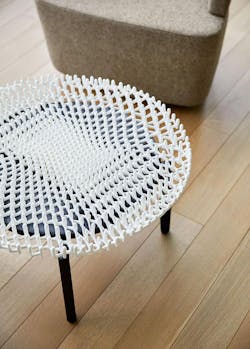MIT’s Self Assembly Lab presents Rapid Liquid Printing, a 3D printing method that they claim will produce stronger structural parts in shorter time. Rather than using a layering method in free space, RLP extrudes materials into a vat of gel to create smoother and stronger line objects.
Courtesy of Designboom
So far, the team’s structures were exhibited at Milan's Furniture Fair with product designer Christophe Guberan. Their largest object was a lace tabletop for Bassline, a new table collection by furniture company, Steelcase. Building furniture allows the team to experiment with various structures to demonstrate the holding strength of their parts.
Courtesy of MIT Self Assembly Lab, Steelcase
Printing inside a gel eliminates the needs for other external supports that have to cater to the design of the structure that is being printed. The gel “self heals”, or converges back to its original state after the extruder needle passes through it so as to not leave empty space in the gel. RLP uses a chemical reaction within the gel to harden the material instead of light or heat curing.
The line structure looks effortless compared to thin line structures produced by layer 3D printing, which are often rigid and brittle. When referring to a lace tabletop produced by RLP, Turnstone senior designer, Yuka Hiyoshi comments on “line quality” of the material, calling it “soft”, and “almost organic”.
“It evokes images of brushstrokes or the branches of plants,” he says.
While the .gif below does not depict actual speed, the process is still much faster than 3D printing. It simply extrudes lines with thickness that depends on the extruder, rather than tediously repeating small layers of materials to create angled lines. Tibbits says that the lace table top would usually require 50 hours to print with layering methods, but only took 30 minutes to print with RLP. The gel takes 1 hour to set. He adds that smaller structures with more detail would likely take more time.
Courtesy of Designboom
MIT plans to continue their research experimenting with other materials. So far, Self Assembly Lab founder, Skylar Tibbits says the team has been able to use plastics, foams, rubbers and even metals.




